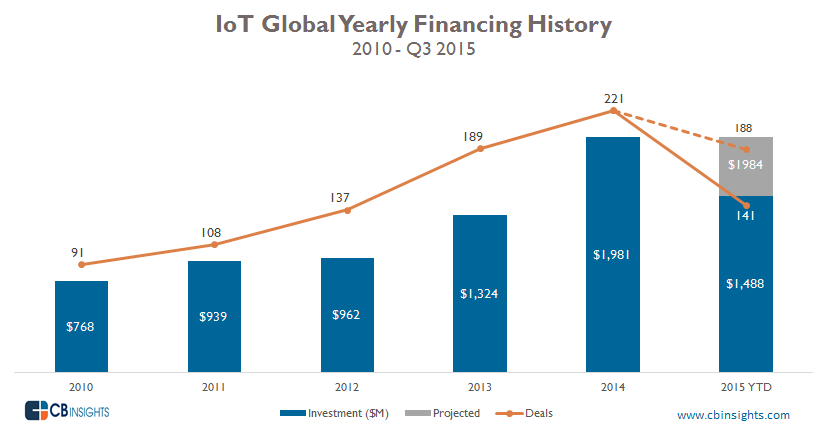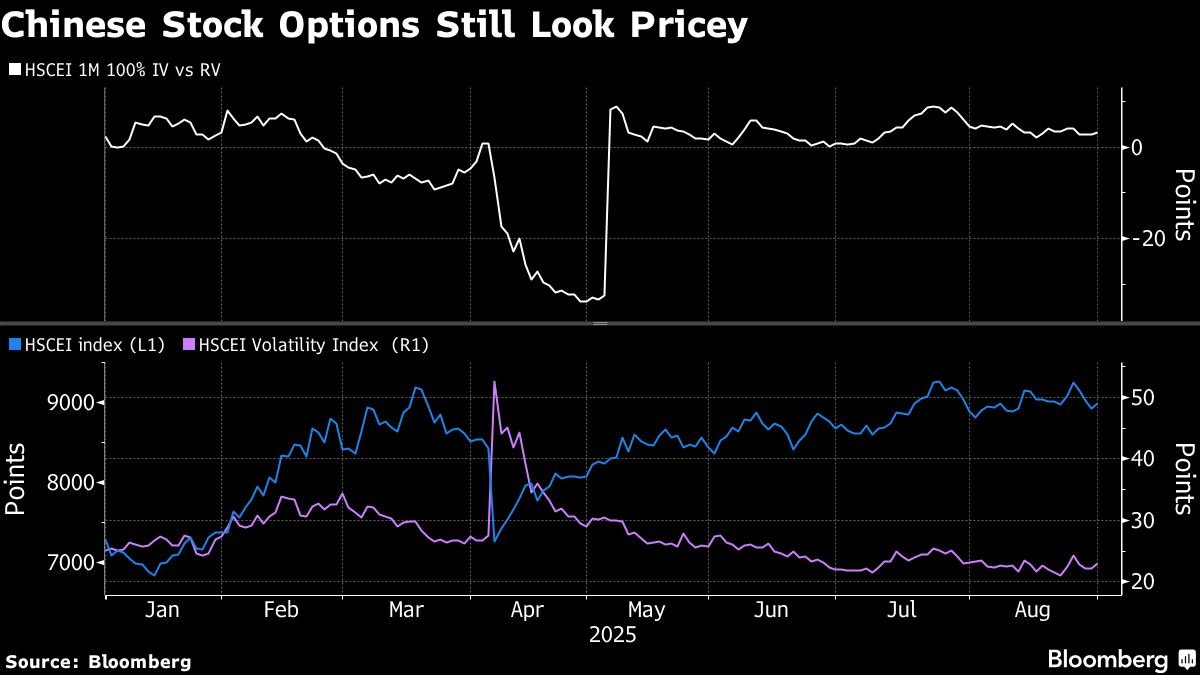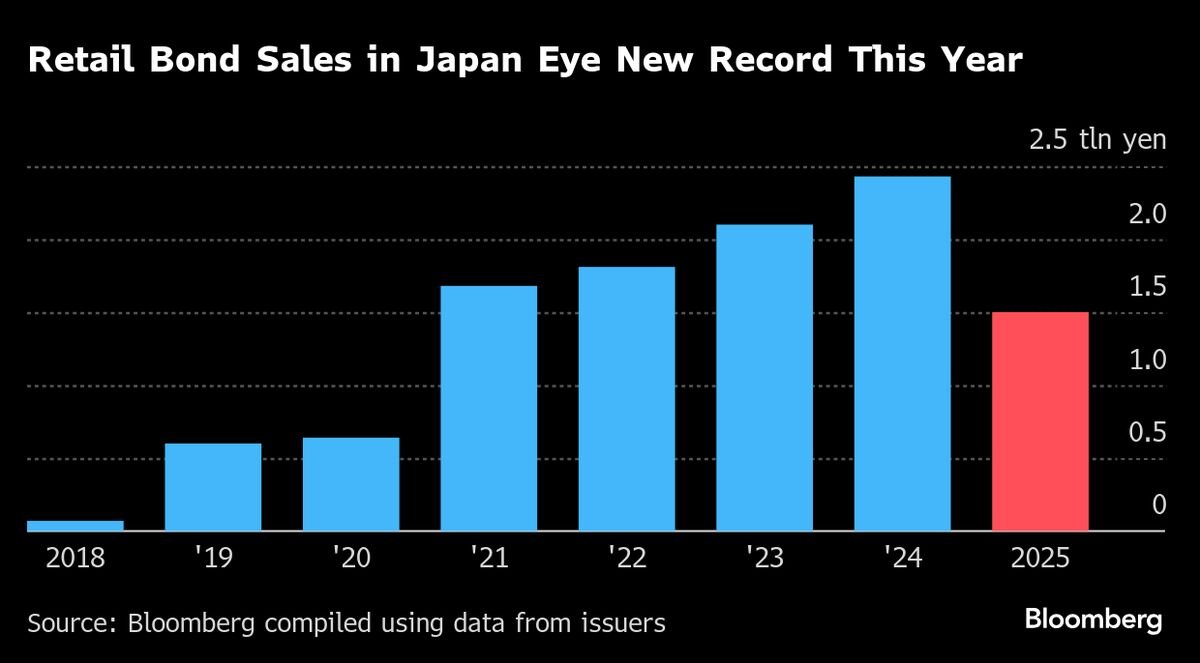Funding & Business
Funding to IoT Startups Has More Than Doubled In Six Years

The Internet of Things is the next major phase in computing, following on the heels of the PC and mobile eras. According to one estimate, the IoT will encompass between 20 and 30 billion connected devices by 2020.
Using CB Insights data, we examined investments in IoT startups, including deals and funding, investments by stage, most well-funded companies, and active investors. In the past six years, the IoT space has attracted a cumulative $7.4B in investment over 887 deals.
IoT startups include companies commercializing connected objects, appliances, sensors, and devices, along with supporting infrastructure and software. A few of the categories include medical devices, connected home appliances, and smart building materials.
Yearly IoT funding
Funding to IoT startups has grown at a steady clip, more than doubling in 5 years from $768M in 2010 to over $1.9B in 2014. Yearly deal count soared from 91 in 2010, to 221 in 2014. And, at the current run-rate, 2015 is on track to eclipse last year’s record-breaking funding year, despite the deal count being down significantly from last year.
Quarterly deals and dollars
The quarterly history offers a more detailed look at the rise in IoT funding. There has been $500M in investment in private IoT companies 4 of the last 6 quarters.
Deal count has also grown substantially. In 2010 and 2011, deal count hovered around 25 in each quarter. In 2014 and 2015, the count has jumped to a range of 34 to 65 deals each quarter. The top funding quarter was Q2’15 with $626M in funding, bolstered by a $75M Series B to drone manufacturer DJI Innovations, and a $45M Series F to mixed-reality gaming company Orbotix.
Deal and dollar share by investment stage
The shares of IoT deals by investment stage have held relatively constant, with a trend towards early stage deals that peaked in 2013, with Seed and Series A deals combining for 62% of deal share. That share has since retreated a bit to 53% in 2015’s first three quarters.
Mid-stage companies generally saw about one quarter of deals between 2010 and Q3’15, but climbed up to 20% in 2015 year-to-date. And late stage deals accounted for between 7% and 14% of deals.
In terms of dollar share, however, deals don’t skew toward the early stage.
Mid-stages deals account for the greatest dollar share in every year except 2012, and so far in 2015 mid-stage accounts for 52% of IoT funding. In 2014 and 2015 YTD, late-stage funding (Series D and Series E+) accounted for 22% and 31% of dollars, respectively.
Most well-funded companies
The most well-funded companies represent a diverse range of categories, including IoT infrastructure, cloud platforms, and consumer wearables.
The most well-funded company was View, maker of an internet-connected smart window and environmentally-friendly building glass. View recently raised $150M in a Q3’15 Series G round.
View was followed by Proteus Digital Health, a company that makes ingestible sensors to measure medication adherence and physiological responses. Proteus most recently raised $52M in a second Series G round in Q3’14.
The third most well-funded company was Jawbone, a wearables and smart electronics maker. The company most recently took on a $300M debt round in Q2’15.
See the full list, below:
Active investors
Intel Capital tops the list as the most active investor in IoT startups, followed by Qualcomm Ventures. Both companies’ venture arms have been active investors in wearables startups, which as IoT devices are typically powered by small chips.
This year, Intel Capital led a round to BodyLabs, a maker of 3D body-scanning sensors, and also invested in Sano Intelligence, a biometric sensor developer. Intel Capital has also invested in wearables companies and made bets on IoT infrastructure startups like Stratoscale, Bocom Intelligent Network Technologies, and SigFox.
Next most active was Qualcomm Ventures, which recently invested in the drone company 3D Robotics, along with Whistle Labs, maker of a dog wearable. Qualcomm Ventures also invested in sensor networks developed by Panoramic Power, Placemeter, and Streetline, which all aim to harness the IoT to measure traffic and increase the efficiency in public spaces.
The third-most active investor was Foundry Group, the Boulder, Colorado-based early-stage venture fund. Foundry Group has made multiple bets on IoT-related hardware investments: Fitbit, LittleBits, and MakerBot. (Fitbit went public in June at a valuation of $4.1B, and MakerBot was acquired in Q3’13 at a $403M valuation.)
Drilling into just early-stage investments we see many familiar names on the most active investors list. Once again, Intel Capital is the leading early-stage investor, followed by Khosla Ventures, which notably invested in enterprise IoT companies including Helium and Quanttus. In third was Foundry Group, which notably invested in the Q2’15 seed round for ivee, a home voice assistant.
Want more data about top Internet of Things (IoT) companies? Login to CB Insights or sign up for free below.
Feature image credit: Maurizio Pesce. Creative Commons license Attribution 2.0 Generic.
If you aren’t already a client, sign up for a free trial to learn more about our platform.
Funding & Business
China’s Stock Rally Is Met With Skepticism in Options Market

While Chinese stocks traded in Hong Kong climbed for a fourth straight month, derivatives wagers show investors are skeptical about the market.
Source link
Funding & Business
SoftBank, Rakuten Tap Japan’s Booming Retail Demand for Bonds

Sales of corporate bonds to Japan’s mom and pop investors are booming, on track to surpass last year’s record as bigger returns draw buyers looking to protect their savings from inflation.
Well-known names such as railway operator Keio Corp. and supermarket giant Aeon Co. are among those tapping the retail bond market, with the latter selling its debut retail bond on Friday.
Funding & Business
Tame US Job Growth Expected in Approach to Fed Meeting

Employers in the US showed little enthusiasm to take on workers during August, and the unemployment rate probably ticked up to an almost four-year high, adding to evidence of a more subdued labor market.
Economists project about 75,000 jobs were added, based on the median of a Bloomberg survey, while the jobless rate is seen at 4.3%. Four straight months of sub-100,000 payrolls growth would mark the weakest such stretch since the onset of the pandemic in 2020.
-
Tools & Platforms3 weeks ago
Building Trust in Military AI Starts with Opening the Black Box – War on the Rocks
-

 Ethics & Policy1 month ago
Ethics & Policy1 month agoSDAIA Supports Saudi Arabia’s Leadership in Shaping Global AI Ethics, Policy, and Research – وكالة الأنباء السعودية
-

 Events & Conferences3 months ago
Events & Conferences3 months agoJourney to 1000 models: Scaling Instagram’s recommendation system
-

 Jobs & Careers2 months ago
Jobs & Careers2 months agoMumbai-based Perplexity Alternative Has 60k+ Users Without Funding
-

 Business1 day ago
Business1 day agoThe Guardian view on Trump and the Fed: independence is no substitute for accountability | Editorial
-

 Funding & Business2 months ago
Funding & Business2 months agoKayak and Expedia race to build AI travel agents that turn social posts into itineraries
-

 Education2 months ago
Education2 months agoVEX Robotics launches AI-powered classroom robotics system
-

 Podcasts & Talks2 months ago
Podcasts & Talks2 months agoHappy 4th of July! 🎆 Made with Veo 3 in Gemini
-

 Podcasts & Talks2 months ago
Podcasts & Talks2 months agoOpenAI 🤝 @teamganassi
-

 Jobs & Careers2 months ago
Jobs & Careers2 months agoAstrophel Aerospace Raises ₹6.84 Crore to Build Reusable Launch Vehicle

